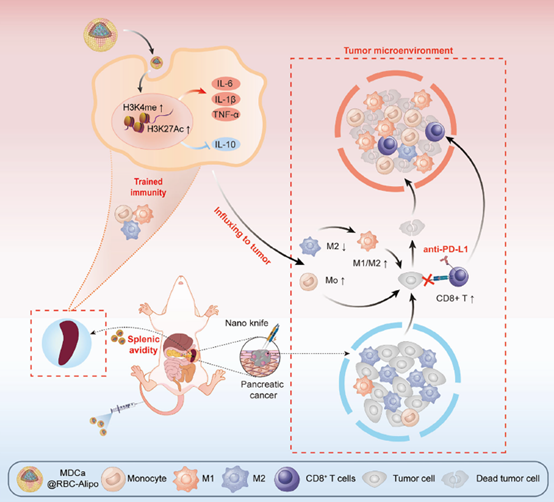- Cart 0
- English
IF 14.1: Nanobiologics Targeting Splenic Myeloids Break PDAC Therapy Deadlock
October 17, 2025
Clicks:109
Pancreatic ductal adenocarcinoma (PDAC) remains one of the most lethal malignancies, with a five-year overall survival below 7 %. High rates of local recurrence and distant metastasis after irreversible electroporation (IRE), together with limited efficacy of current immune-based therapies, constitute a long-standing clinical bottleneck. A study recently published in Advanced Science now offers a rational solution: nanobiologics that home to splenic myeloid cells and induce anti-tumour peripheral trained immunity, markedly improving IRE outcomes in pre-clinical PDAC models. Absin’s four-colour multiplex fluorescent IHC kit (abs50028) served as a key histo-phenotyping tool and is proud to have empowered this breakthrough.
Title: Targeting Splenic Myeloid Cells with Nanobiologics to Prevent Post-ablative Pancreatic Cancer Recurrence via Inducing Antitumor Peripheral Trained Immunity
Journal: Advanced Science (IF 14.1)
DOI: https://doi.org/10.1002/advs.202413562
Key reagent: Four-colour multiplex fluorescent IHC kit (anti-rabbit secondary) (abs50028)


I. Background: the “double bind” of PDAC therapy
Two major hurdles persist:
· Limited cytoreduction by IRE: although FDA-approved, IRE cannot eradicate all tumour cells, leading to rapid local recurrence;· Immune-refractory TME: PDAC harbours an immunosuppressive microenvironment that blunts adaptive T-cell responses, while trained-immunity-based strategies remain largely unexplored.
The authors observed that PDAC progression remodels the splenic immune landscape—myeloid cells (monocytes/macrophages) expand while cytotoxic T and B cells drop. Targeting these splenic myeloid populations to induce tumouricidal trained immunity therefore emerged as a rational therapeutic angle.
II. Strategy: rational design of MDCa@RBC-Alipo nanobiologics
The team engineered a multimodal nanobiologic—MDCa@RBC-Alipo—with the following features:
1. Spleen-homing vector: hybrid vesicles composed of erythrocyte membrane (spleen-reticuloendothelial tropism) and apoA1-decorated liposomes for myeloid targeting;2. pH-responsive cargo: CaCO₃ nanocores loaded with muramyl dipeptide (MDP), releasing MDP in acidified lysosomes to avoid systemic degradation;
3. Trained-immunity programming: MDP triggers epigenetic rewiring (H3K27ac, H3K4me3) of splenic myeloid cells, boosting TNF-α/IL-6 while suppressing IL-10, thereby generating a tumouricidal phenotype;
4. Therapeutic synergy: trained myeloid cells infiltrate residual tumours post-IRE, sensitising them to PD-L1 blockade and creating an “ablation + trained immunity + ICB” tri-modal regimen.

Fig. 1: Schematic of MDCa@RBC-Alipo inducing anti-tumour trained immunity.
III. Key results: marked recurrence suppression and survival benefit
In subcutaneous and orthotopic PDAC mouse models MDCa@RBC-Alipo showed:
· Splenic immune rewiring: elevated CD11b⁺ myeloid fraction, reduced M2 macrophages, increased pro-inflammatory cytokines;· Recurrence control: post-IRE residual tumour volume shrank >60 % compared with IRE-only controls;
· Survival extension: median survival reached 72 d versus 40 d in controls (80 % increase) with effective suppression of bloody ascites;
· Favourable safety: no weight loss or hepatorenal toxicity, no histopathological damage to major organs.
Immune-phenotyping by multiplex fluorescent IHC was central to validating these outcomes—enter abs50028.
IV. Powered by Absin: abs50028 for high-content immune profiling
To quantify infiltrating immune subsets (CD206⁺ M2 macrophages, CD8⁺ T cells, Foxp3⁺ Tregs, etc.) in spleen and tumour tissues, the authors used Absin’s four-colour multiplex fluorescent IHC kit (abs50028):
1. Need: simultaneous detection of multiple markers (CD3, CD8, CD206, Foxp3) with cellular resolution;2. Merits of abs50028: high specificity, low background, compatible with high-resolution whole-slide imaging;
3. Quantitative read-outs:
(1) 3-fold increase in intratumoural CD8⁺ T cells after MDCa@RBC-Alipo;
(2) 40 % reduction in M2 macrophages (CD206⁺) and elevated M1/M2 ratio;
(3) Decreased Foxp3⁺ Tregs when combined with αPD-L1.

Fig. 4: Representative multiplex images (abs50028) showing CD206 and CD3 distribution in control vs treated tumours.
V. Absin at a glance—more than reagents, your innovation partner
Beyond abs50028, Absin offers multiplex IHC kits spanning 2- to 10-plex and custom mIHC services, empowering researchers to map the tumour microenvironment with single-cell resolution.
Reference:
Wu S, Xu W, Shan X, et al. Targeting Splenic Myeloid Cells with Nanobiologics to Prevent Post-ablative Pancreatic Cancer Recurrence via Inducing Antitumor Peripheral Trained Immunity. Adv Sci. 2025;12(2413562). DOI: 10.1002/advs.202413562
Product used in the study:
| Cat. # | Name | Size |
|---|---|---|
| abs50028 | Four-colour multiplex fluorescent IHC kit (anti-rabbit) | 20T/50T/100T |
More Recommended Products:
|
Cat. # |
Name |
Size |
|
Absin 4-Color IHC Kit (Anti-Rabbit and Mouse Secondary Antibody) |
20T |
|
|
Absin 4-Color IHC Kit(Anti-Rabbit Secondary Antibody) |
20T |
|
|
Absin 5-Color IHC Kit (Anti-Rabbit and Mouse Secondary Antibody) |
20T |
|
|
Absin 5-Color IHC Kit (Anti-Rabbit Secondary Antibody) |
20T |
|
|
Absin 6-Color IHC Kit (Anti-Rabbit and Mouse Secondary Antibody) |
20T |
|
|
Absin 6-Color IHC Kit (Anti-Rabbit Secondary Antibody) |
20T |
|
|
Absin 7-Color IHC Kit (Anti-Rabbit and Mouse Secondary Antibody) |
20T |
|
|
Absin 7-Color IHC Kit(Anti-Rabbit Secondary Antibody) |
20T |
|
|
Antibody Stripping Solution (for mIHC) |
30mL |
Contact Absin
Absin provides antibodies, proteins, ELISA kits, cell culture, detection kits, and other research reagents. If you have any product needs, please contact us.
| Absin Bioscience Inc. worldwide@absin.cn |
 Follow us on Facebook: Absin Bio Follow us on Facebook: Absin Bio |
